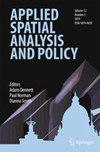An Integrated Land-Use, Population, and Transport Model for Strategic Regional Planning: From Research to Operational Practice
Abstract
Land-Use and Transport Interaction (LUTI) models have long been regarded as important tools for urban modelling and planning. Despite methodological advances, LUTI models remain underutilised in practice. Practitioners are often reluctant to use complex models that typically demand extensive data requirements, long processing times and call for highly trained and specialised staff. To mitigate these issues and strike a balance between parsimony and comprehensiveness, the current study develops one of the first operational LUTI models in Australia, POPulation and Dwelling Allocation Modelling (POPDAM), achieved via an academic-government collaborative co-design process. POPDAM comprises two integrated modules. The econometric module uses a demand–supply model of dwelling allocation and is grounded in hedonic price and equilibrium theories. The demographic module employs a cohort progression model to produce age-sex scenarios. In contrast to popular micro-level modelling, POPDAM operates at a higher level of spatial granularity allowing simpler implementation but without compromising its practical utility. This meso spatial scale was proven sufficient for policy testing while capturing higher-level economic and demographic trends that may be obscured in individual-based models. This trade-off between simplicity and accuracy yields an optimal computational performance streamlined to mere minutes for scenario execution. Moreover, the co-design project-orientated process bridging academia and government has resulted in a successful implementation of POPDAM alongside an effective transfer of knowledge. The conceptual design of POPDAM provides a level of abstraction that can be easily re-deployed to other situational contexts in Australia and beyond.

 求助内容:
求助内容: 应助结果提醒方式:
应助结果提醒方式:


